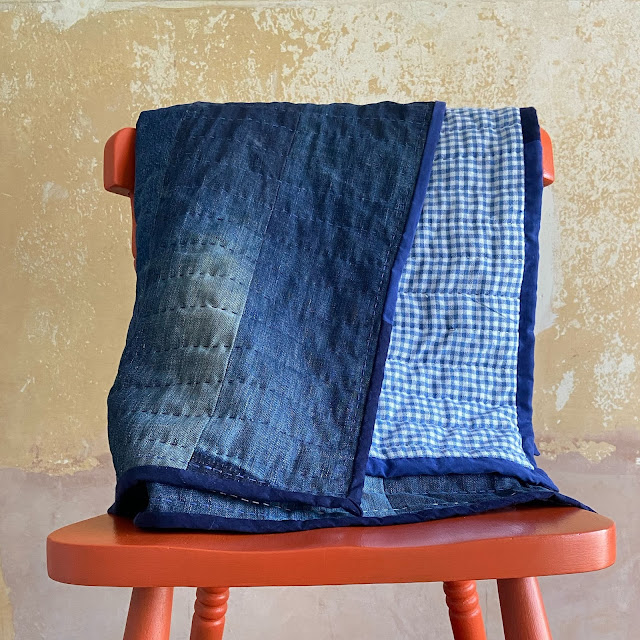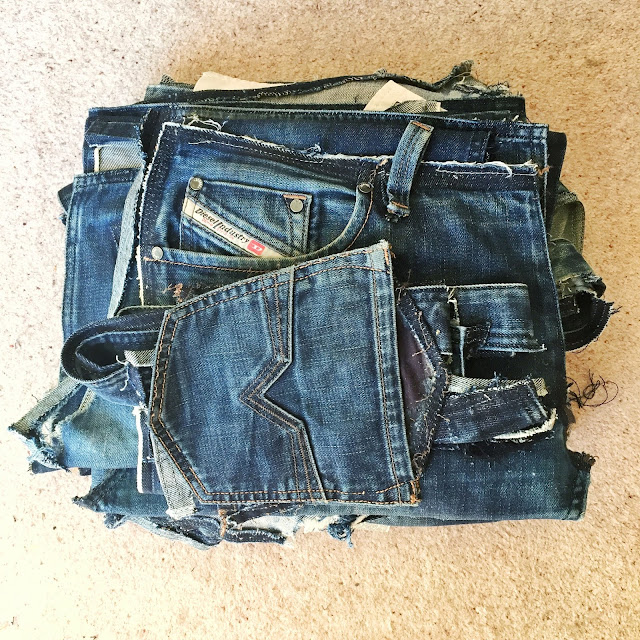Indigo blue - recycling denim into a quilt
We all have our favourite denim jeans, the ones we feel most at home in, the ones you return to at the weekend because they are the most comfortable and no one will judge you for the inconvenient hole showing your pants. They are a wardrobe staple. When your favourite pair is no longer decent even for the garden, there is usually a whole lot of usable fabric still remaining. Denim is a fabric that ages beautifully, each crease a history of its wearer and as distinctive as a fingerprint, memory imprinted into cloth and impossible to throw away.
Denim has a fascinating history, its a uniquely woven cotton invented by weavers in the French city of Nimes (the name 'denim' derives from 'de Nimes'). A strong hardwearing textile, its distinctive ageing process results from the difference in the dyed outer warp threads and inner white weft threads. It became popular as a strong resilient fabric during the American Gold Rush of the late 1800s and by 1920 denim trousers were the leading item in men's workwear. From 1930, denim trousers became the star of the silver screen, modelled by gunslinging cowboys such as John Wayne and in later years, stars such as Marlon Brando and James Dean. Denim jeans became synonymous with the American West, youth and sub culture and have since become perhaps the world's most popular item of clothing since its humble beginnings.
I was determined to use as much of the fabric as I could, painstakingly unpicking waist bands and pockets and these revealed beautiful difference in colour which I tried to use in the design.
Never having made a quilt before, it sort of grew organically, I had no real idea of what might be its final size. Pieces were hand sewn together after laying them into a giant denim jigsaw, moving them around to try to show off the different colours and patterns in the best way possible. I knew I wanted to to incorporate sashiko thread in colours to match the denim and that I wanted it to appear as random as the growth of the patchwork itself.
 |
For the backing cloth, I chose some simple gingham. Another fabric with a long and interesting history, gingham was possibly first manufactured in Dutch-colonised Malaysia and exported to Europe in the 17th century. The name gingham is thought to derive from the Malaysian word genggang meaning striped and adopted by the Dutch although many other countries claim ownership of this simple woven cotton cloth. It became associated with country style and was popular on the American frontier of the mid 1800s for curtains, tablecloths and practical workwear, growing in use by the 1920s as a suitable fabric for school uniforms before also becoming adopted by the Hollywood stars of the 30s and 40s. It's homespun style became symbolic of simpler times and domestic bliss, dropping out of favour a little from the 80s to 90s before a late resurgence during these turbulent times. To keep with the recycled theme, I edged it in strips of leftover indigo cotton from a dressmaking project mingled with strips of an old blue cotton shirt, bought second hand and originally from Savile Row. In total the project cost about £20 in materials.
It's very tactile, soft, the denim is old and well worn and turned out the perfect size to cover a double bed, a sea of old and familiar blue to dream under. Each ripple in colour a memory of a night on a beach, a holiday, a season in the garden, trudging a city's streets, living our ordinary lives, unique and made by us.










Comments
Post a Comment